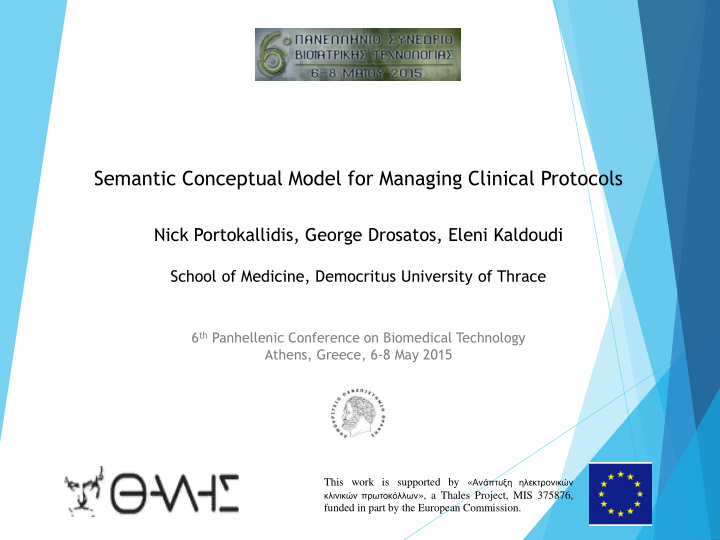



Semantic Conceptual Model for Managing Clinical Protocols Nick Portokallidis, George Drosatos, Eleni Kaldoudi School of Medicine, Democritus University of Thrace 6 th Panhellenic Conference on Biomedical Technology Athens, Greece, 6-8 May 2015 This work is supported by « Ανάπτυξη ηλεκτρονικών κλινικών πρωτοκόλλων », a Thales Project, MIS 375876, funded in part by the European Commission.
Clinical protocol vs Clinical guideline Clinical protocols are rigid Clinical practice guidelines or statements allowing little or no C PG’s are systematically flexibility or variation. A developed statements designed protocol sets out a precise to help practitioners and sequence of activities to be patients decide on appropriate adhered to in the management healthcare for specific of a specific clinical condition. Recommendations Ground truth Educational Material Safety measures Always evolving Static Flexible Apply only in clinicians Semantic Conceptual Model for Managing Clinical Protocols
Our goal: semantic protocol description Protocol creation and adaptation speed up Clinicians can provide immediate feedback on protocol applications and variations Health organizations leverages protocol recommendations to establish new protocols Decision support systems (DSS) can take advantage of Electronic protocol database and metadata Quick and effective response in health crisis when no specialized clinicians are available at that time Easier CP merging to address patient comorbidities thanks to protocol metadata description Semantic Conceptual Model for Managing Clinical Protocols
Clinical Protocol ontologies DILEMMA Generic Protocol Model (DGPM) Introduces protocol model and inheritance Cannot fit to modern health care patterns Core Clinical Protocol Ontology (C2PO) Introduces protocol recommendations Developed in OWL using modern tools SEMPATH and Clinical Pathway Ontology (CPO) Internal modelling of CP on rules and validation software Semantic Conceptual Model for Managing Clinical Protocols
Our contribution Create a 2-layer social network of clinical protocols and clinicians Native protocol recommendations Comments and protocol promotions Easier conversion from guidelines to protocols Introduce protocol evolution Through forking process Use adaptive protocols in smaller regions Semantic Conceptual Model for Managing Clinical Protocols
Results and implementation Ontology engineering Developed in OWL, using Protégé Model properties with mappings to medical standards Linked Data ready using Bioportal Commercial software integration Visionware LIMS Entity – Relations Diagram Organized by 5 main entities Using 8 core entity relations Semantic Conceptual Model for Managing Clinical Protocols
Semantic conceptual model Therapeutic Diagnostic Staff PHR record Protocol source Patient Requirements forked from utilized for Evidence source result Specialty Name Release Protocol Expert Doctor has utilization utilized by Disease utilized at is member of approved by updated to Health Center Patient Cohort Semantic Conceptual Model for Managing Clinical Protocols
Thank you! Any Questions? Semantic Conceptual Model for Managing Clinical Protocols
Acknowledgement This work is partly funded by eCP: Electronic Clinical Protocols, MIS 375876, a National and Kapodistrian University of Athens project funded under the Greek National Programme Thales , co- funded by the European Commission Coordinator: I. Skalkidis Semantic Conceptual Model for Managing Clinical Protocols
Recommend
More recommend